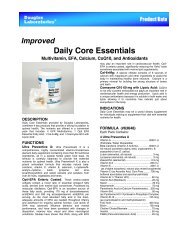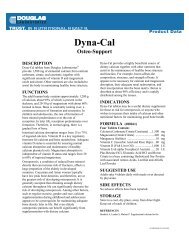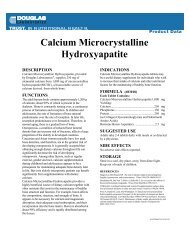Douglas Laboratories NutriNews FINAL
Douglas Laboratories NutriNews FINAL
Douglas Laboratories NutriNews FINAL
You also want an ePaper? Increase the reach of your titles
YUMPU automatically turns print PDFs into web optimized ePapers that Google loves.
Neither the recognition nor the treatment of heavy metaltoxicity is an isolated event. A patient may have periods ofweeks to years where they are highly functional and productive,interspersed with periods of being nonproductive andhaving a difficult time completing tasks. These patients may bediagnosed with psychological problems including: borderlinepersonality disorders, anxiety, schizophrenia spectrum disorders,attention deficit hyperactivity disorder, learning disabilities,depression, obsessive-compulsive disorder, manicdepressive disorder, and panic attacks. All of these conditionsmay in some way be correlated to mercury intoxication.Additionally, some studies have investigated possible relationshipsof mercury levels to emotional disturbances in children.Subtoxic metal levels previously thought to be harmless arenow being associated with hyperactivity, impulsiveness anddecreased attention span.In the Handbook of Toxicology of Metals, it is noted that“…at present, there is no suitable biological index of the mercuryconcentration in critical organs such as the brain…”Mercury is ubiquitous in our environment. Today the averageperson’s body contains about 10-15 mg of mercury. Mercuryis employed by medical and dental practitioners, found indrugs, used by agriculture in fungicides and pesticides and bythe cosmetics industry as an antibacterial. Mercury in industrialwaste has also polluted our waters and contaminated ourfresh and salt water plants and fish.Methylmercury and elemental mercury are the two formsmost likely to be involved in human exposures in our environment.Elemental mercury is converted by bacteria to the moretoxic methylmercury. Ingested methylmercury is absorbedthrough the GI tract while inhaled mercury vapor is retainedby the pulmonary system. Skin absorption of mercury mayalso occur.1. Methylmercury (recent exposure to organic mercurywithin last 90 days): This form is from industrial pollution andgold mining. It accumulates mainly in the aquatic food chain.Greater than 95% is found in food, particularly fish (higherlevels in shark, swordfish, tuna (canned, fresh/frozen),salmon, halibut. It tends to concentrate in the brain where itacts as a potent neurotoxin and teratogen.Testing for Acute Exposure —utilizing hair, urine, blood and feces2. Elemental (all other chronic exposures): Silver amalgamfillings are 50% Hg content. While the American DentalAssociation says it is stable, its release is increased by chewingfood, chewing gum, tooth grinding, drilling or polishingteeth as well as consuming hot drinks.Testing for Chronic Exposure —utilizing hair, fractioned urine porphyrinBiochemical effects: Mercury binds covalently withsulfhydryl groups, especially those contained in hemoglobin,glutathione (GSH), and cysteine. It reduces glutathione synthase/reductase,selenium and vitamin E, and forms insolublecomplexes with selenium, therefore decreasing selenium levels.It promotes formation of prooxidants such as hydrogenperoxide, lipid peroxides and hydroxyl radicals. Most importantly,it affects the Phase II detoxification pathway in the liver.After entry into the body, the liver is the main organ that neutralizestoxic compounds where they undergo metabolicchanges whereby lipid soluble compounds are converted intopolar, water-soluble products for purposes of excretion fromthe body. Phase I detoxification is where foreign compoundsare converted to more potent or less potent compounds,readying them for the next phase of processing, which isPhase II detoxification. In Phase II detoxification metabolitesproduced in Phase I are combined with endogenous moleculesand become less toxic and harmful, more water-soluble andtherefore readily available for excretion.7





